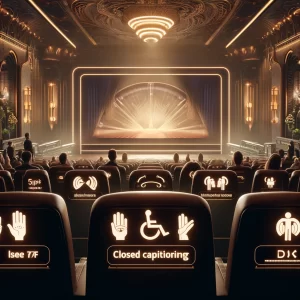The Ministry of Information & Broadcasting (MIB) recently on 15th March 2024 introduced guidelines aimed at enhancing accessibility standards for persons with hearing and visual impairments in the public exhibition of feature films in cinema theatres. Read Guidelines here.
The guidelines seek to ensure that everyone can partake in the cinematic experience. These standards, developed after extensive consultations with various stakeholders, mark a significant step forward in fostering inclusivity in society. They have included the requirements of various methods and tools for promoting accessibility to persons with disabilities.
It is important to note that, the focus of these guidelines have not been limited only to the content itself but also covers the assistive devices and other support required by persons with disabilities to enjoy films in cinema theatres, which is in my opinion are a commendable move by the ministry.
Applicability:
Guidelines apply to those feature films including trailers, promos, etc., certified by the Central Board of Film Certification (CBFC) for public exhibition in cinema halls/movie theatres for commercial purposes. “Feature Film” has been defined in the guidelines as a fictionalized story film running not less than 72 minutes.
Key Features of the Guidelines
These guidelines are in accordance with the Rights of Persons with Disabilities Act, 2016, which emphasizes universal access and inclusion in all aspects of life, including access to films. Some of the key features of the Guidelines are as follows:
- Accessibility Features:
- Accessibility features for hearing impairments is provided of Closed Captioning (CC/OC) where both the audio dialogue and sound representations of a film are made visible via on-screen text that is synchronized with the content.
- Accessibility feature for visual impairment is provided of Audio Description (AD) which is the auditory narration of visual representations in a film.
- Further, Indian Sign Language has to be provided for the hearing impaired, which video shall be visible in a picture-in-picture mode at the bottom-right hand of the screen.
- CBFC Filing with Accessibility Features: Film Producers shall be required to submit films along with all the accessibility features, such as Audio Description, Closed Captioning and/or Indian Sign Language by Interpreters, while applying to the CBFC for certification of the film. The guidelines mandate theatres to ensure that feature films have all the files for accessibility features which are certified by CBFC, and CBFC shall ensure certification accordingly.
- Equipment to be used by Theatres: To promote inclusive viewing, the cinema theatres shall provide accessibility features of at least 2 to 5 equipment per 200 seats for both CC & AD. There are various options to deploy the accessibility features in Theatres which include:
-
- Mirror Captions – mirrors in the cup holder of seat reflecting inverted captions played at the back of the cinema for viewing;
- Closed Captioning Smart Glasses – that displays captions at the bottom of the glasses;
- Closed Caption Stands – with a flexible pole and rectangular screen to display captions;
- Closed Caption Display below the Screen – A separate small screen immediately below the big screen with synchronized projection display of captions/subtitles;
- Headphones/Earphones for Audio Description (AD) – provided through headphones or earphones attached to specific AD-enabled seats;
- Through the use of mobile applications;
- Other technologies as available in the market.
- Implementation Schedule: The timeline to adhere to the guidelines are as follows:
- Feature films to be certified in more than one language must comply within six months from effective date;
- Feature films to be submitted to Film Festivals organized by Ministry, etc., must comply with effect from 1st January, 2025.
- All other Feature Films being certified through CBFC including the teasers and
trailers and meant for theatrical release (digital feature films), would be required
to mandatorily provide accessibility features for CC/OC & AD, from 2 years from
the date of issue of these guidelines.
- Monitoring Committee: A committee, appointed by Ministry of Information and Broadcasting (MIB), which would comprise 50% members who are individuals with hearing/visual disabilities and representatives from the film industry, will supervise the enforcement of accessibility standards.
- Grievance Redressal: In cases where accessible features are not available, viewers can file a complaint with the relevant licensee of the theatre. If no response is received within 30 days, then the viewer can lodge a complaint to the Committee, which will promptly address the complaint within a timeframe of 30 days.
Overall, these guidelines lay a solid foundation for ensuring accessible feature film content and theatre infrastructure, thereby promoting greater inclusion in society.
Recent Development
The Delhi High Court has recently urged the Centre to expedite the notification of guidelines for making films accessible to individuals with hearing and visual impairments, setting a deadline of July 15.[i]
It was ordered as follows: “The guidelines shall now be finalised by the MIB and shall be notified on or before 15th July, 2024. It is made clear that the said guidelines shall make the provision of accessibility features mandatory and provide a reasonable period for compliance by all stakeholders, in an expeditious manner”.
The central government expressed its commitment to notifying the guidelines promptly, seeking an extension until August 1 to consider stakeholders’ responses.
Read order here.
Conclusion
This move by the Government follows Akshat Baldwa v. Yash Raj Films,[ii] wherein Justice Pratibha M. Singh had earlier observed accessibility as “crucial and is enforceable as a legal right” and even private parties have to ensure that “reasonable accommodation” measures are taken in order to enable greater accessibility for the hearing and visually impaired persons. It was observed that hearing or visually impaired person, may get physical access, but not be able to enjoy the film, if measures are not taken by the stakeholders.
Therefore, the introduction of accessibility guidelines for cinema halls in India is a significant move towards aligning with accessibility standards and promoting inclusivity in the entertainment industry. As films are a powerful means of storytelling and shared experiences, ensuring accessibility is required to make sure that nobody due to disabilities beyond their control miss out on enjoyment of such art form.
[i] https://www.livelaw.in/high-court/delhi-high-court/delhi-high-court-mib-notify-guidelines-cinema-accessible-visually-hearing-impaired-persons-253561
[ii] W.P.(C) 445/2023 & CM APPLs.1752-53/2023
Image generated on Dall-E

















Comments are closed.